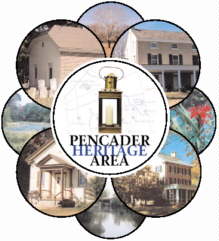 The rivers and streams provided one of the earliest modes of transportation in Pencader Hundred. Queen Christina of Sweden was twelve years old when the Swedes landed in Delaware and eighteen when she became queen. The Indian name for the river, Minqua, was changed to Christina in honor of their youthful queen. Beloved as a young woman, she fell out of favor as she aged and changed her benevolent ways to those of a selfish, egotistical, extravagant ruler. After twice abdicating the throne she moved to Rome and changed her name to Alexandria. The Americans now had a river named after someone in disfavor-so they changed the name to Christiana. In 1937 the Delaware Legislature passed an act which restored the original name to the river. The final insult to the historical waterway occurred when the construction of Interstate 95 passed through Pencader and a section of the streambed was moved one quarter of a mile to the east.
The rivers and streams provided one of the earliest modes of transportation in Pencader Hundred. Queen Christina of Sweden was twelve years old when the Swedes landed in Delaware and eighteen when she became queen. The Indian name for the river, Minqua, was changed to Christina in honor of their youthful queen. Beloved as a young woman, she fell out of favor as she aged and changed her benevolent ways to those of a selfish, egotistical, extravagant ruler. After twice abdicating the throne she moved to Rome and changed her name to Alexandria. The Americans now had a river named after someone in disfavor-so they changed the name to Christiana. In 1937 the Delaware Legislature passed an act which restored the original name to the river. The final insult to the historical waterway occurred when the construction of Interstate 95 passed through Pencader and a section of the streambed was moved one quarter of a mile to the east.
The earliest settlers, the Dutch and the Swedes, showed little interest in building roads and located their homes along the Delaware and Christina as well as along the many lesser creeks. It was not until the latter part of the 1600s that the need for better roads became a concern. In 1675 an order from the Governor stating roads were to be built from 'place to place' met largely with noncompliance, even under the threat of a fine of ten gilders, a fine raised in 1878 to a hogshead of tobacco. The courts further ordered, that every person, as far as his land reaches, make good and passable ways from neighbor to neighbor.
Settlers on the Welsh Tract in 1723 petitioned the New Castle and Cecil County Courts for a road from the Head of Elk (Elkton) to Christina Bridge connecting to a road to New Castle. This toll road was first called the Old Post Road and is now known as Old Baltimore Pike. One of the toll gates was at Cooch's Bridge, at the intersection of another main road in Pencader, the road leading from The Buck Tavern to Glasgow and then on to Newark, which became old Route 896.
In 1775 stagecoaches began running between Baltimore and Philadelphia with one leg of the journey covering the distance from New Castle to Frenchtown, on the north end of the Elk River in Maryland, at the head of the Cheapeake Bay. Nearly the same route was later used by the New Castle and Frenchtown Turnpike which was completed in 1816. It also was a toll road, with a tollgate at the southwest corner of the Pencader Church graveyard.
The stagecoaches were uncomfortable and always at the mercy of the weather. The roads, choked with dust in the summer and composed of bottomless mud when it rained, were vividly described by Francis Baily, a traveler passing through Pencader on his way to New Castle in 1796:
It was four o'clock before we started; and we had not proceeded far on these miserable roads, ere night overtook us; and as the fates would have it, our unlucky coachman drove us into a miry bog; and in spite of all our endeavours, we could not get the coach out again; we were therefore obliged to leave it there, with the whole of the baggage, all night; and were driven to the necessity of seeking our way in the dark to the nearest house, which was about a mile and a half off; there getting ourselves cleaned, and a
good supper, we went to bed.
Mr. Baily did not indicate that the muddy, hungry travelers walked to an Inn, which leads one to speculate how often those living by the side of the road were called upon to be a friend of man in the middle of the night!
Long past, a little railroad, set
On sills of stone its wicket,
The old canal is flowing yet,
The railroad's but a thicket;
G.A.Townsend
|
